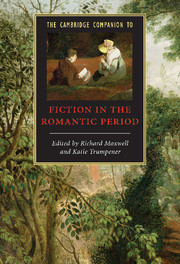Book contents
- Frontmatter
- Introduction
- 1 The historiography of fiction in the Romantic period
- 2 Publishing, authorship, and reading
- 3 Gothic fiction
- 4 The historical novel
- 5 Thinking locally: novelistic worlds in provincial fiction
- 6 Poetry and the novel
- 7 Orientalism and empire
- 8 Intellectual history and political theory
- 9 Women writers and the woman’s novel: the trope of maternal transmission
- 10 Tales for child readers
- 11 Sentimental fiction
- 12 Fiction and the working classes
- 13 The Irish novel 1800-1829
- 14 Scotland and the novel
- Further reading
- Index
- Series List
4 - The historical novel
Published online by Cambridge University Press: 28 January 2009
- Frontmatter
- Introduction
- 1 The historiography of fiction in the Romantic period
- 2 Publishing, authorship, and reading
- 3 Gothic fiction
- 4 The historical novel
- 5 Thinking locally: novelistic worlds in provincial fiction
- 6 Poetry and the novel
- 7 Orientalism and empire
- 8 Intellectual history and political theory
- 9 Women writers and the woman’s novel: the trope of maternal transmission
- 10 Tales for child readers
- 11 Sentimental fiction
- 12 Fiction and the working classes
- 13 The Irish novel 1800-1829
- 14 Scotland and the novel
- Further reading
- Index
- Series List
Summary
The historical novel begins as a French genre. Its formative instance, The Princess of Cleves (1678), was the work of Madame de Lafayette, a sophisticated insider at the court of Louis XIV. Cleves is focused on a disastrous moment in French history, when Henry II died from injuries suffered at an anachronistically feudal tournament, thus accelerating the country's path towards the Wars of Religion (1562-98), fought over freedom of religion and the division of power among various cliques. This national crisis is counterpointed with the heroine's dazzling debut at court and the irresolvable love dilemmas that develop out of it. The fictive princess is held up as both exemplary and inimitable: an impossible figure of virtue in a corrupt world collectively headed for disaster.
Until the early nineteenth century, Cleves remained the most famous and widely read example of historical fiction. A generation later, the abbé Prévost developed a second persuasive version of this long-lived but elusive genre. A much less respectable character than Lafayette, Prévost fled to Holland and England in an effort to avoid various theological and financial quandaries. Partly as a result of his exile, he became fascinated with English, Scottish, and Irish history, which provide the main historical mooring for his three great novels of the 1730s: Memoirs and Adventures of a Man of Quality (1728-31), The English Philosopher, or the History of Monsieur Cleveland (1731-9), and The Dean of Killerine (1735-40).
- Type
- Chapter
- Information
- Publisher: Cambridge University PressPrint publication year: 2008
- 2
- Cited by



